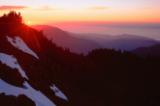 © Pete Saloutos/Panoramic Images (Washington Title Image Large)
© Pete Saloutos/Panoramic Images (Washington Title Image Large)

Conservation Overview
Landscapes in Washington range from the ocean shores in the west, to moist, conifer-covered slopes and snow-capped volcanic peaks, and then to arid grasslands in the rain shadow on the east side of the mountains. In fact, most of the American West’s major ecosystem types occur within the state, including two unique ones: the Olympic rainforest and the channeled scablands of the Columbia Plateau. These varied habitats support a tremendously diverse range of plant and animal life.
Washington also hosts a rapidly growing human population with resultant development pressure. Though the need for land protection exists throughout the state, the threats are greatest in the Columbia Plateau and Puget Trough ecoregions, where many priority species and ecosystems are facing rapid habitat loss.
Our highest-priority challenges to land conservation include:
• Habitat loss through conversion, fragmentation and degradation. For instance, demand for wine grapes is displacing native shrub-steppe habitat.
• Displacement of native species by invasive plant and animal species. Scotts broom is a fierce competitor in South Sound prairies.
• Changes in climate and other processes. Fire suppression, to protect rural home sites, has drastically changed forest structure.
• Increasing water demands and decreasing supply. Winter snowpack is decreasing but water demand for irrigation is increasing and salmon are suffering.
These problems call for immediate and concerted action. Current conservation efforts in Washington rely on cooperation and coordination among many partners, including state and federal agencies, tribal governments, private conservation organizations, and private landowners. Notable among these are:
• Washington Biodiversity Council, a state-mandated partnership charged with developing a comprehensive 30-year plan to establish priorities and strategies (emphasizing incentives) to protect the state’s natural heritage.
• Puget Sound Partnership, a community effort of citizens, governments, tribes, scientists and businesses working together to restore and protect Puget Sound.
• Salmon Recovery is managed by more than two dozen local, watershed-based, organizations and involves many state, county, and local government agencies; several federal agencies; native Indian tribes; local citizen groups; conservation organizations; schools; and private corporations.





